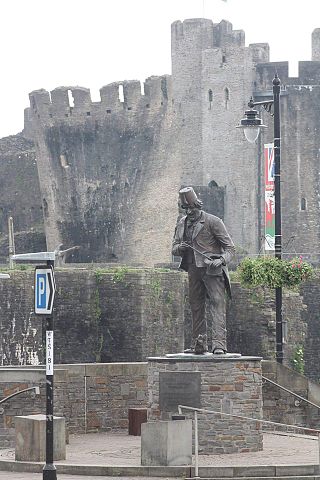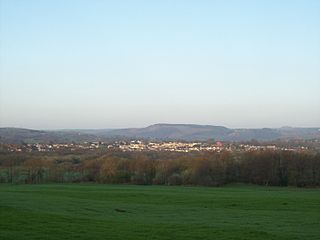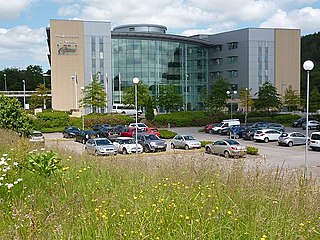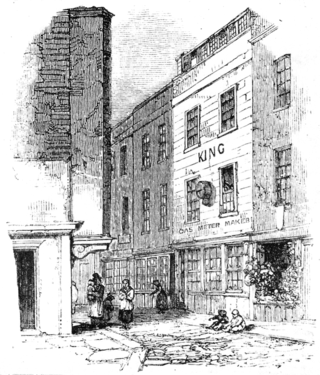
Caerphilly is a town and community in Wales. It is situated at the southern end of the Rhymney Valley.

Rhymney is a town and a community in the county borough of Caerphilly, South Wales. It is within the historic boundaries of Monmouthshire. With the villages of Pontlottyn, Fochriw, Abertysswg, Deri and New Tredegar, Rhymney is designated as the 'Upper Rhymney Valley' by the local Unitary Authority, Caerphilly County Borough Council. As a community, Rhymney includes the town of Rhymney, Pontlottyn, Abertysswg, Butetown and Twyncarno.

Llanishen is a district and community in the north of Cardiff, Wales. Its population as of the 2011 census was 17,417.
The Rhymney Railway was a railway company in South Wales, founded to transport minerals and materials to and from collieries and ironworks in the Rhymney Valley of South Wales, and to docks in Cardiff. It opened a main line in 1858, and a limited passenger service was operated in addition.

Ystrad Mynach is a town in the Caerphilly County Borough, within the ancient county of Glamorgan, Wales, and is 5 mi (8.0 km) north of the town of Caerphilly. The urban area has a population of 19,204, and stands in the Rhymney Valley. Before the Industrial Revolution and the coming of coal mining in the South Wales Coalfield the valley was rural and farmed. It lies in the community of Gelligaer.

Machen is a large village three miles east of Caerphilly, south Wales. It is situated in the Caerphilly borough within the historic boundaries of Monmouthshire. It neighbours Bedwas and Trethomas, and forms a council ward in conjunction with those communities. It lies on the Rhymney River. Mynydd Machen provides a view over the village. It is possible to walk up to and along the top of the mountain, where a number of large boulders are present.

Tredegar House is a 17th-century Charles II-era mansion on the southwestern edge of Newport, Wales. For over five hundred years it was home to the Morgan family, later Lords Tredegar; one of the most powerful and influential families in the area. Described as, "the grandest and most exuberant country house in Monmouthshire" and one of the "outstanding houses of the Restoration period in the whole of Britain", the mansion stands in a reduced landscaped garden of 90 acres (0.36 km2) forming the non-residential part of Tredegar Park. The property became a Grade I listed building on 3 March 1952 and has been under the care of the National Trust since March 2012. The park surrounding the house is designated Grade II* on the Cadw/ICOMOS Register of Parks and Gardens of Special Historic Interest in Wales.

Dyrham Park is a baroque English country house in an ancient deer park near the village of Dyrham in South Gloucestershire, England. The house, with the attached orangery and stable block is a Grade I listed building, while the park is Grade II* listed on the National Register of Historic Parks and Gardens.

Hartlebury Castle, a Grade I listed building, near Hartlebury in Worcestershire, central England, was built in the mid-13th century as a fortified manor house, on manorial land earlier given to the Bishop of Worcester by King Burgred of Mercia. It lies near Stourport-on-Severn in an area with several large manors and country houses, including Witley Court, Astley Hall, Pool House, Areley Hall and Hartlebury and Abberley Hall. Later, it became the bishop's principal residence.

Rhymney Valley was one of six local government districts in Mid Glamorgan from 1974 to 1996.

Nelson is a village and community in the County Borough of Caerphilly, Wales. It sits five miles north of Caerphilly and ten miles north of Cardiff, at the lower end of the Taff Bargoed Valley, and lies adjacent to Treharris, Trelewis and Quakers Yard.

Caerphilly County Borough Council is the governing body for Caerphilly County Borough, one of the Principal Areas of Wales. The last full council elections took place 5 May 2022.

Ysgol Gyfun Cwm Rhymni is a Welsh-medium school situated in the village of Fleur-de-Lys in the Rhymney Valley. Cwm Rhymni was founded in 1981 with just over 150 pupils and has since grown to 1,684 pupils with 1,164 at the Gellihaf campus and 520 at Y Gwyndy.
This page is a list of High Sheriffs of Glamorgan. Sheriffs of Glamorgan served under and were answerable to the independent Lords of Glamorgan until that lordship was merged into the crown. This is in contrast to sheriffs of the English shires who were from the earliest times officers of the crown. Sheriffs in the modern sense, appointed and answerable to the crown, were instituted in the county of Glamorgan in 1541.

The following is a list of reportedly haunted locations in the United Kingdom.

Preston Manor is the former manor house of the ancient Sussex village of Preston, now part of the coastal city of Brighton and Hove, England. The present building dates mostly from 1738, when Lord of the manor Thomas Western rebuilt the original 13th-century structure, and 1905 when Charles Stanley Peach's renovation and enlargement gave the house its current appearance. The manor house passed through several owners, including the Stanfords—reputedly the richest family in Sussex—after several centuries of ownership by the Diocese of Chichester and a period in which it was Crown property.

Pwll-y-Wrach or Pwllywrach is a historic manor house to the east of Colwinston, Vale of Glamorgan, south Wales. The house and its Western garden house and Eastern garden house are all listed as Grade II listed buildings in their own right. The gardens themselves are designated Grade II on the Cadw/ICOMOS Register of Parks and Gardens of Special Historic Interest in Wales. The novelist Agatha Christie was a frequent visitor to the village and stayed at the house with her daughter Rosalind, son-in-law Hubert Prichard, and her only grandchild Mathew; her descendants, the Prichard family, still live at the former manor.

Morgraig Castle is a ruined castle, which lies close to the southern borders of the county borough of Caerphilly, overlooking Cardiff in Wales. It was built in the 13th century, but there is some debate as to who actually built the castle, either Gilbert de Clare or the Lord of Senghennydd. The castle appears to have never been occupied or completed. It is now a scheduled monument and a Grade II listed building.

Energlyn & Churchill Park railway station is a railway station in Caerphilly, Wales, on the Rhymney Line. The northbound platform is in the Energlyn suburb of Caerphilly, whilst the southbound one is in Churchill Park. The station is between Llanbradach and Aber.

In the United Kingdom, the term listed building refers to a building or other structure officially designated as being of special architectural, historical, or cultural significance; Grade I structures are those considered to be "buildings of exceptional interest". Listing was begun by a provision in the Town and Country Planning Act 1947. Once listed, strict limitations are imposed on the modifications allowed to a building's structure or fittings. In Wales, the authority for listing under the Planning Act 1990 rests with Cadw.



















